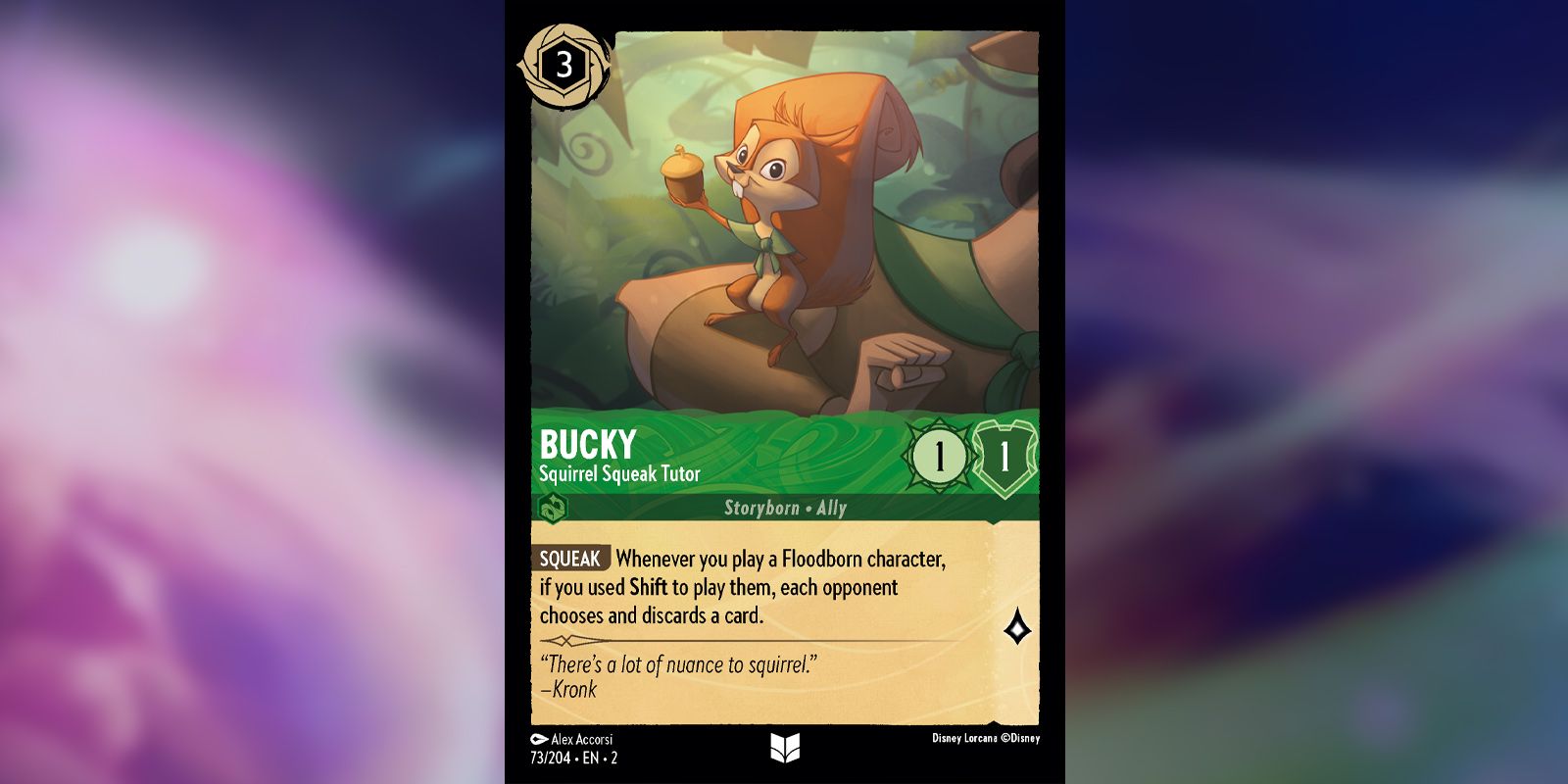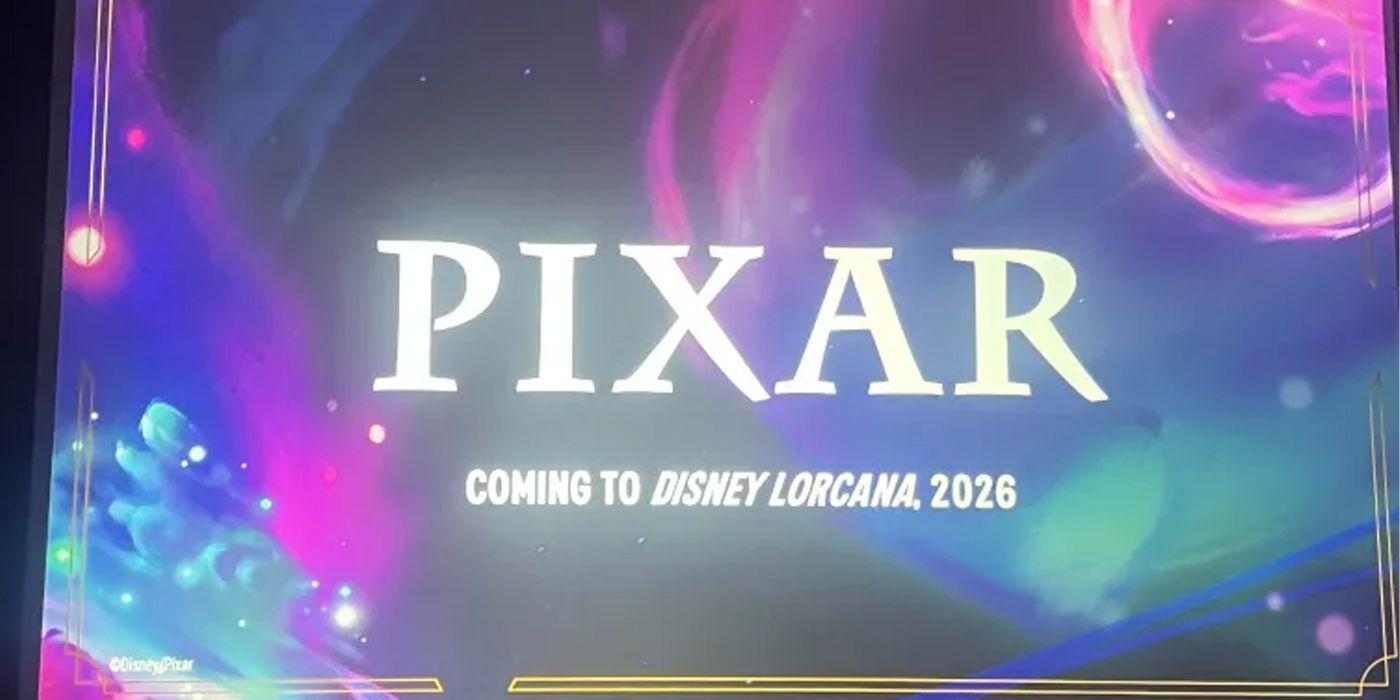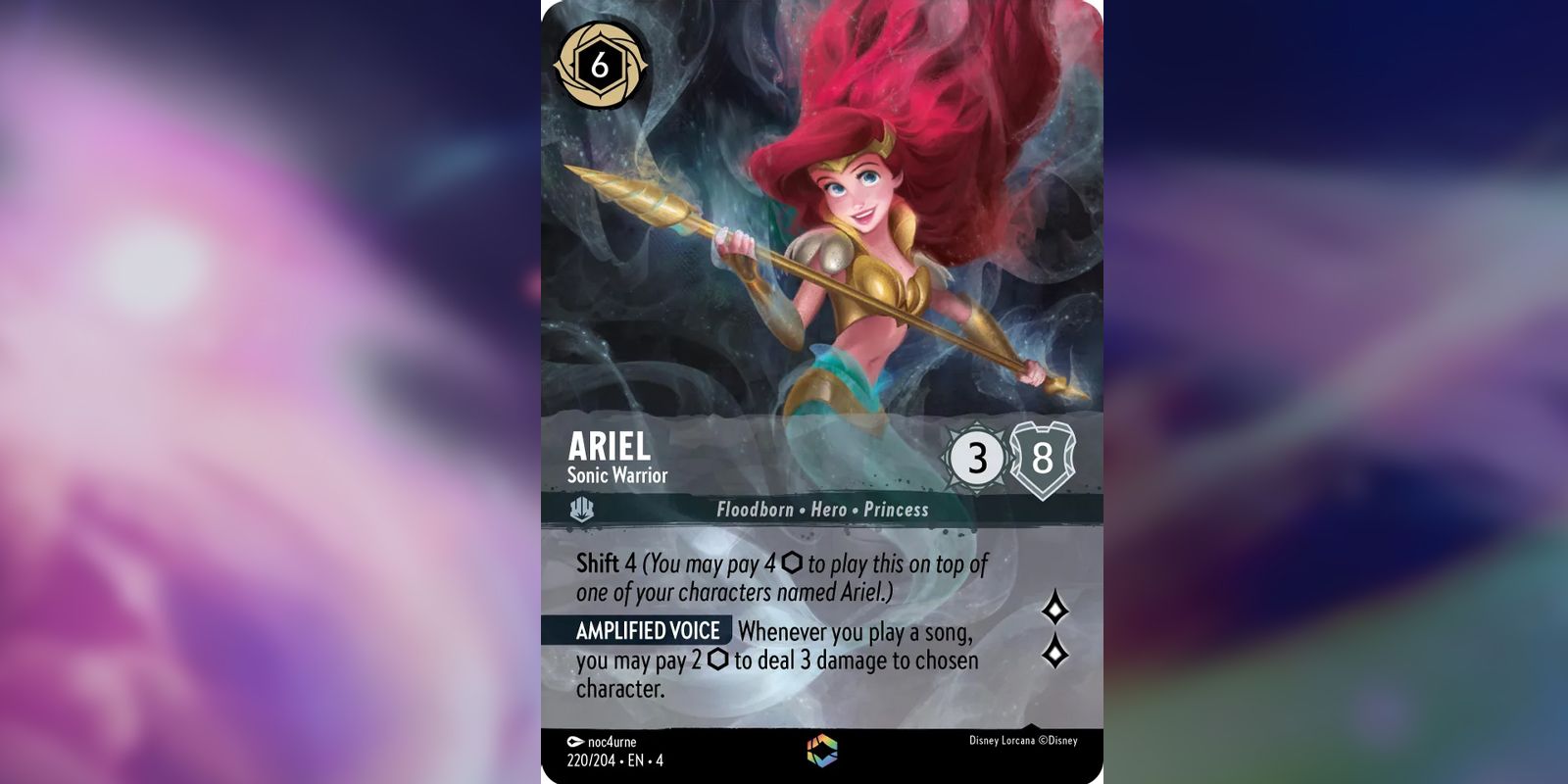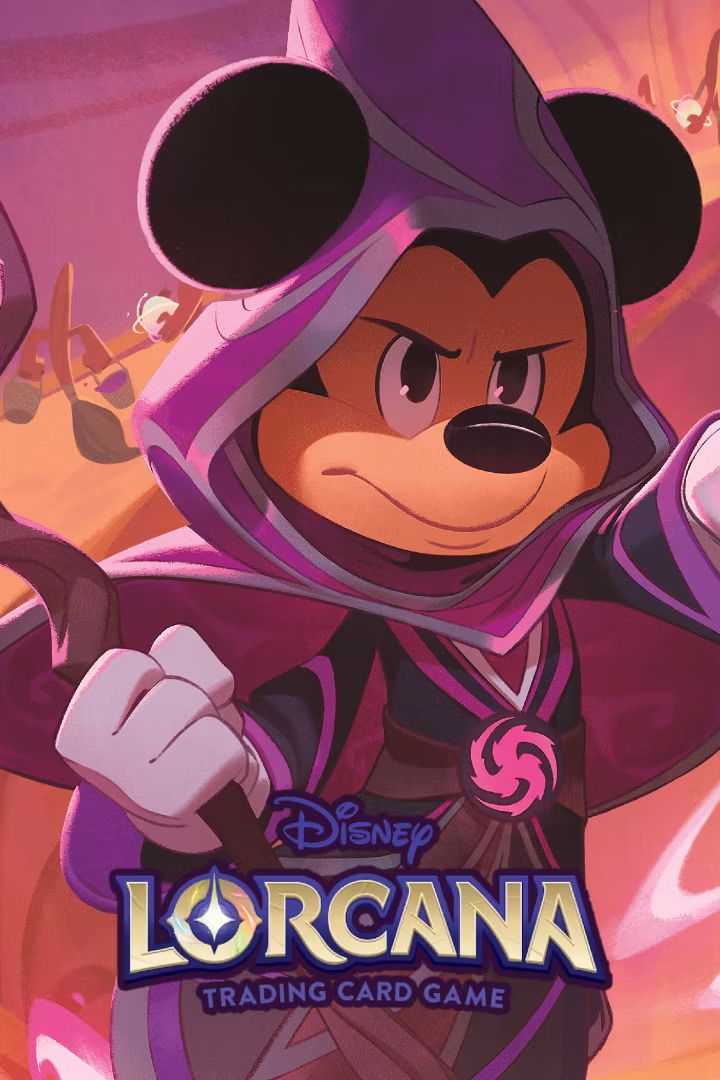Summary
-
Disney Lorcana
announced the integration of Pixar cards into gameplay at D23, which is very exciting news for fans. - Co-designers Ryan Miller and Steve Warner shared insights into game design and the recent Bucky errata, geared towards improving player experience.
- The duo also teased details about the upcoming collaboration with Pixar, which will be the perfect synergy with Lorcana’s emotional storytelling and whimsy.
One of the biggest hits at D23 2024: The Ultimate Disney Fan Event was undeniably the Ravensburger booth, which was almost always at capacity, and often bustling with players trying their hand at Disney Lorcana. Though still in its infancy, the ultra-popular trading card game has been rising exponentially since its original launch in August 2023. Fans had even more reason to celebrate the game’s first anniversary, thanks to the exciting announcements made at Friday’s panel.
Lorcana recently unveiled its fifth set Shimmering Skies, which included fun new cards from movies like Wreck-it Ralph and The Emperor’s New Groove, but now it’s branching out in a whole new direction. Not only is a set from Rescue Rangers on its way, but 2026 will see Pixar movies incorporated into the gameplay. With new cards also come new events for players, with a world championship (and a unique Golden Mickey card to accompany it) set as well as a less competitive Lorcana Quest being put into place.
Related
Disney Lorcana: The World’s Rarest Card, Upcoming Characters & New Events – Everything Revealed At D23
Attending D23 2024, Screen Rant breaks down every major announcement from the Disney Lorcana panel, celebrating the next two years of the TCG.
Screen Rant had the chance to visit the packed Ravensburger booth at D23, where the line of fans waiting eagerly to get their hands on exclusive cards and new sets was incredible to witness. While there, we interviewed Lorcana co-designers Ryan Miller and Steve Warner about the latest announcements from D23, including the upcoming Lorcana Pixar set, the decision-making process for Bucky’s errata, and much more.
Taking Lorcana Cards From The Mind’s Eye To The Hand’s Deck
Screen Rant: You guys had some exciting announcements about upcoming cards at the panel. How long and arduous is the process between suggestions and implementation for this game?
Ryan Miller: Well, the story starts as many adventures do, in a tavern. There was a bar called The Famous in Glendale, and this was even before I came along. Steve, were you at The Famous?
Steve Warner: I wasn’t at the bar. I worked for Ravensburger, but they didn’t need me there.
Ryan Miller: Ravensburger has been working with for about 60 years, right? And so one of the things they’ll do is these summits where licensees come in, and they all talk. “What are our plans? What do we want to do?” One night after one of these meetings, the Ravensburger folks went to The Famous and were like, “Where are we NOT now and where do we want to be, as far as game spaces?” Then somebody, and it’s unclear who, said, “What if we did a trading card game based on Disney?”
Phil [Wrzesinski], who at the time was North America Games, then contacts his counterpart in Disney. He literally steps out of the bar and calls and, basically, they go, “Yeah, let’s talk about it.” And he comes back in with a big grin on his face, and that’s kind of where it really started.
Steve Warner: Yeah, I remember my boss came up to me, and he’s like, “Do you think that we could do a Disney trading card game?” And I’m like, “Well, yeah! Yeah, I think we can.” And from there it was a lot of questions on how to get started, what we needed, and how to do things. But once we got the green light to really get started and come up with game designs, I knew I needed to get on it with Ryan. He was already working with me on Princess Bride, which was a lot of fun. Ryan and I have known each other for 22 years now.
Ryan Miller: We came up together through Wizards of the Coast. We were in retail and then we worked at R&D there. And he’s just like a brother to me. He was in my wedding, so the chance to work with this guy on a Disney game?
I’ve been a Disney fan since I was a little boy. I grew up three hours north of here. My grandmother would, every once in a while, take me down to Disneyland. It’s just to me the very special coming together of some of my favorite things, Disney, gaming, Steve – it’s just all coming together.
When you have a specific new card or set announced – for example, Rescue Rangers – what are the conversations there between saying, “Hey, we want to try this one,” and, “How is this character going to work?” How long does that take and what factors go into that?
Ryan Miller: Obviously, there’s Disney approval in art and stuff like that, but really it’s a conversation. They’ve been amazing collaborators.
I have three ingredients to a great experience. It’s love, attention to detail, and hard work. When you think about Disney and what they do, it just lines right up with that. Attention to detail is the most important because that is how we show love, and that’s why our collaboration at Disney is so great because they’re all about that attention to detail and that love.
What we start with is Steve’s team and our narrative team working together to decide, “Okay, which franchise do we want to include in this set?” And marketing is also on that team as well to say, “Okay, what is popular?” Then we think about, “What are some good deep cuts and some the beloved treasures out there that we can include?” Really, I think, a lot of it starts there.
Steve Warner: Once we agree on what we think the story’s going to be and the mechanics that’ll match up with that really well, we work really hard to craft a lot of the cards that are going to work well together and play well together and be really exciting. We want to give those feelings from the movie, so that people can really relive that magic.
The Truth About Bucky & Thoughts On Further Errata
Bucky has just been given the first errata, or card rework, in Lorcana history. How do the team make these decisions and could we see more in the future?
Ryan Miller: I think… He’s not too powerful. I think I want start with that. It wasn’t a power issue; it was that he was creating such an unfun environment, relieving you of your ability to play the game and non-interactive. I think Discard is fine and necessary, though.
Steve Warner: With Bucky, it wasn’t so much that he was too powerful. We were paying a lot of attention to the events and how they were playing out, but with the people that we had going to the events and talking to people and all the information that came back. It wasn’t that he was overpowered, but that he just wasn’t fun to play against. And that’s the absolute last thing that we wanted in the game because the whole point should be having fun.
I think we can’t say that it won’t happen again. If there’s another part that does exist that creates a lot of non-fun games, then we can’t let it stay around.
Is that something that comes from, like you said, hosting all these events and receiving feedback? How has the live community aspect helped shape Lorcana?
Ryan Miller: We also look at the decks that are bubbling to the top. You can see the deck list, and we’re watching the matches and things like that on our live stream, so we can really see what’s going on there. I think that’s really important.
I like to say that doing functional errata is basically what we did here. We call it functional errata because we’re changing the functionality of a card. It’s one of those buttons that we never want to push if we can avoid it. Same with banning a card – we never want to push it if we can avoid it.
However, we do want to live in this world where we’re making exciting and fun cards. Sometimes when you do that, you tread that line of not only power but of utility and interactivity and things like that. We want to live in that world where we make exciting cards, but I’d rather live in a world where we occasionally have to push those buttons than one where everything is either underpowered or more super-balanced because that is less fun.
Frankly, it’s a lot harder to build a deck when all the cards are essentially the same power level. You’re just like, “I don’t know. This card? That card?” What do you do? It’s much more fun when there’s that strata of utility. That’s something we worked on many games together and that we see eye-to-eye on. It’s really important to have really fun and exciting cards to open up.
The other factor here is that the players are always going to play the game far more than we will. We have an awesome team. Steve runs the game design team, they’re outstanding, but they will never play as many games as our players. They’re playing far more games than we could ever play. Of course, Bucky was a known factor. It’s not like he was a surprise; the surprise was how much use he got. He’s not in the top decks either, that’s the other thing. That’s why I know it’s not a power thing.
Steve Warner: Yeah, it won one of the championships but from there it was relatively calm, overall. But he was making things unfun.
Ryan Miller: And the fact is that you couldn’t do anything with him. He doesn’t have to Exert, so you can’t even challenge him. The lack of interactive nature to that card was really the most egregious thing. Discard is necessary to keep other decks in check, but we don’t like Discard as its own strategy.
We Don’t Talk About Bruno (Or Future Lorcana Sets)
Fans have been waiting for Pixar characters, and you’re finally delivering. How do you expect them to fit into or even change gameplay?
Ryan Miller: Well, there’s this character called Bruno from one of my favorite movies, Encanto, and he taught me a very valuable lesson. “We don’t talk about Bruno,” do not it. So, I’m going to call that a Bruno question.
We cannot talk about it, but we’re very excited. Working with Pixar is very exciting. We get to go down to the studio there, which is amazing. It’s the coolest workplace you can ever think of. They’re really passionate, and I love Pixar. They’re attention to emotional intelligence and the emotional resonance of their stories is something they really excel at, so bringing that to Lorcana was one of our dreams from the start.
Pixar is a different branch from classic animated Disney, so I’m sure there were conversations about how to make that fit. Do you guys think that it could branch out further to Marvel and Star Wars, or is that something best left to different games?
Ryan Miller: Again, that’s a Bruno thing. But I do think, when it comes to Pixar specifically, there’s a lot of whimsy there. The wonder that is part of Pixar is something you also see in the animated Disney features and shorts. And so, it was a natural progression. They’re definitely different, but I think that there’s an underlying connective tissue that I think resonates with Lorcana really well.
The Song Of Ariel Sonic Warrior
Steve, what’s been the most challenging from the game design perspective for you?
Steve Warner: There’s always cards that a challenge because there’s a lot of times where we think that we have a lot of good things going on. I remember actually working on this set early on where there was a mechanic that we really wanted to try, but it became way too complex. It was way too much, and we didn’t feel that it was right, so we had to rework things. There’s some semblance of it still on some cards, but we had to make sure that it was not going to distract from the actual game.
Ryan Miller: Yeah, I think one of the rules early on was from the game itself, which was that villains can only challenge heroes and vice versa, which is super dramatic. Like, “Wow, that makes total sense.” But it’s miserable gameplay because if I don’t draw enough villains, then your heroes just go nuts and that’s non-interactive. I can’t do anything, and I’m just watching them.
I remember saying that to you, and you’re like, “Oh, that could work.” Because it sounds very thematic. But then we played it, and it was super prescriptive. “Well, you better have half of your cards to be villains and half be heroes.” Even in that world, you may not draw enough.
But I think the one that came to mind for that question would be your Ariel card.
Steve Warner: Oh, yeah. Ariel Sonic Warrior was one of my first inspirations out of all the cards, and I designed that card early on in the first set.
Ryan Miller: She’s a card that when you play a song card, you can pay some ink, and she can put damage under the character. She can really give your songs some teeth.
Steve Warner: Unfortunately, it wasn’t right in the first set. Then we get to the second set, and it’s still not the right place for that. Third set, fourth set… It’s finally like, “This is perfect.” You’re
fighting Ursula in Lorcana
now. We hate Ursula.Ryan Miller: We finally cracked our champagne. I was like, “You made it, buddy. You made it. How does it feel?”
Steve Warner: Saltwater bubbly!
Ryan Miller: It’s a good example of what you said earlier. Sometimes the mechanics just aren’t right yet because we have to think long-term about the life of the game. It’s not a three-year game, it’s a thirty-year game. We’ve really got to think about that stuff.
That was also a great example of restraint on my friend’s part here, as well as that strategy of, “You know what? If this comes out now, it’s in a funky rule space, and we’ve got to unfold the rules.” The first set was really about introducing you to the world, and then we start unfolding some stuff as we go. It’s a really important part of Lorcana.









